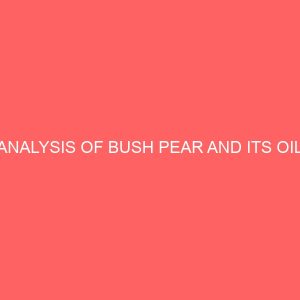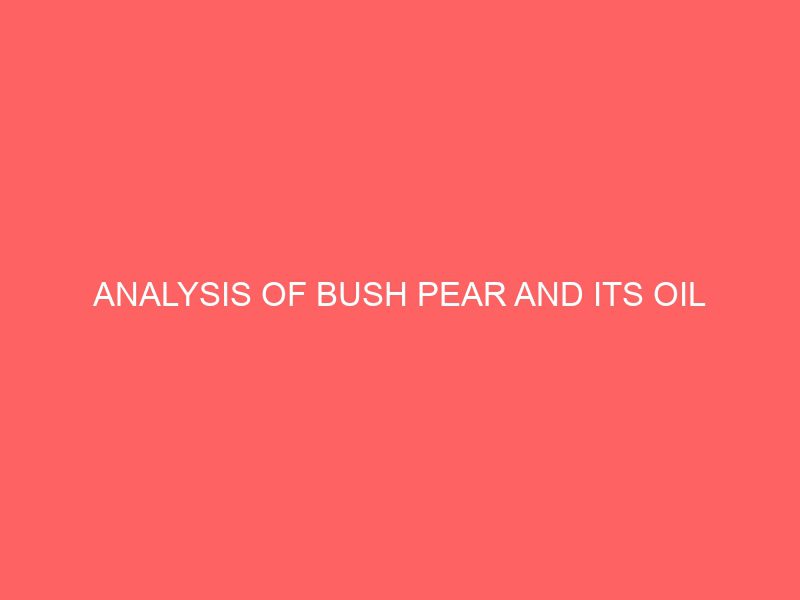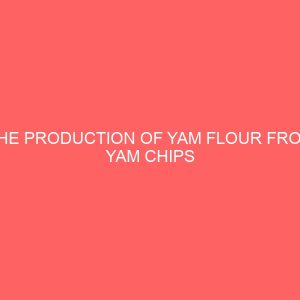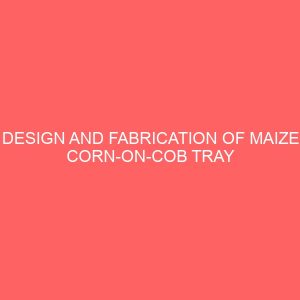ANALYSIS OF BUSH PEAR AND ITS OIL
ABSTRACT
The research project studies the analysis of pear and its oil. The mesocarp from edible African pear DacryodesEdulis were evaluated for their oil yield. The pulp from this pear were oven dried at 100oC105oC to a moisture content level of 29.The mesocarp was subjected to proximate analysis to determine the percentage of the moisture, ash, fat, crude fibre, crude protein and carbohydrate content which resulted to the values of 29, 2, 19.6, 25.5, 11.9, and 12 respectively. Then the dried sample was pulverized by using hammer mill and the oil was extracted by solvent extraction using nhexane. The oil extracted were analyzed for the chemical properties i.e. Acid value, saponification value, peroxide value, iodine value etc. the values obtained are respectively 8.41gm/KOH/gm, 185.1gm/KOH/gm, 2.8gm/KOH/gm 3.96gm/iodine/gm and Physical properties i.e. Refractive index, Ph value, specific gravity which the values obtained are 1.469brix, 5.7 and 0.92. and the The percentage oil yield content is 51.57. This physiochemical characteristic and fatty acid composition of this oil show that they have industrial potentials.
CHAPTER ONE
1.0 INTRODUCTION
In the major world, one major source of protein and vegetable oil is from oil seeds /fruits Williams M. A. 1996. Oil constitutes a well defined class of naturally occurring substance. It is greasy, being soluble in organic solvents but insoluble in polar solvents such as water. Oil is a liquid at room temperature. Commercially, oil as well as fats is sourced from certain plant groups mostly seeds and nuts and some parts of animal within which they occur in relatively large quantity in an easily available form McGrawHill, 1997. The existence of oil in certain plants has been known for century of years Ogbu 2005.Oil can be grouped into edible and nonedible oil depending on the amount of unsaponified matters and impurities contained therein. Edible oil extracted from African pear, bread fruits, cashew nut, peanut etc. are examples of vegetable oil which are naturally occurring esters of higher fatty acids and glycerol, and are predominantly triglycerides with traces of mono and diglycerides, sterples, antioxidants, vitamins, saturated and unsaturated free fatty acids and other minor constituents. They are widely distributed in nature and were first consumed as food. Later, oils were discovered to be used as renewable raw materials for variety of nonfood production. For instance; soaps, creams, disinfectants, paints, enamels, inks etc.
1.1 HISTORICAL BACKGROUND OF THE STUDY
The generic name Dacryodes was derived from the Greek word Dakruon meaning tear referring to resin droplets on the bank surface of its member while Edulis means edible emphasizing the importance of nutrients fruits in the plants cultivation .The plant belongs to the family Burseraceae whose members are characterized by an ovary of 2to 5 cells, prominent as inducts in the bark, wood, and intrasteminal disk Chunduff, 1984. The genus Dacryodes consist of about 10 species Verheji, 2002. However Rehn, 1984 indicated 80 species to encompass sub species of varieties, form and cultivars. Two varieties are recognized; Varparvicarpa and Varedulis whose conical fruit is smaller with the pulp. Varedulis exhibit verticulate or subverticulate branching while the branching is slender and opposite or bifurcate in varparvicarpa Okafor et.al 1983.
1.2 AIMS AND OBJECTIVES
This project is aimed at the analysis of bush pear and its oil.The main objective of this study is to carry out proximate analysis and physiochemical properties of African pear oil extracted by solvent methods. This physiochemical properties determined are specific gravity, refractive index, ph value, boiling point, acid value, iodine value, peroxide value, and saponification value. To achieve the objectives of this project, it is important to:
a Select the best suited solvent for optimum yield.
b Characterize the extracted oil for compositions and properties.
c Test the suitability of the oil.
1.3 STATEMENT OF THE PROBLEM
This research work involves the analysis of African pear and its oil though the food crop African pear potential is rated one of the highest oil producing fruit crop yet it begs the question of its potential.
Furthermore, this project will answer the following questions;
i Solvent extraction by solvent method
ii What is the optimum yield of the particle size using n hexane
iii Is there significant difference in the characterization of the extracted oil as compared to theoretical value in terms of;
1 Chemical properties Acid value, iodine value, saponification value and peroxide value.
2 Physical properties specific gravity, density, viscosity, refractive index.
3 Chemical composition protein crude, fibre, carbohydrate and moisture.
1.4 SIGNIFICANCE/ECONOMIC IMPORTANCE OF THE STUDY
Characterizing the potentials of African pear/African pear oil for many purposes has several implications. Communities in the West African countries are significantly dependent on financial gain from agrarian enterprise.
It is hope that from the project, optimum extraction parameters which are quality of the oil would be established, the result would add to the data bank that could help potential industrialist who intends to go into vegetable table oil production from African pear. A crop that experiences a post harvest loss in excess of 40 in areas where malnutrition is prevalent is a problem for potentials to reclaim the lost percentage of either food or other purposes is advantageous for producers and consumers alike.
1.5 SCOPE AND LIMITATION OF THE STUDY
In this project work, we intend to analyze and extract completely African pear and its oil. Many research work has been done in giving a detailed composition found in African pear. But this research account on the optimum route to:
i Extraction of vegetable oil from bush pear.
ii Separation of pure oil from the solvent.
iii Characterization of the African pear.
Original price was: ₦3,200.00.₦3,000.00Current price is: ₦3,000.00.








Reviews
There are no reviews yet.